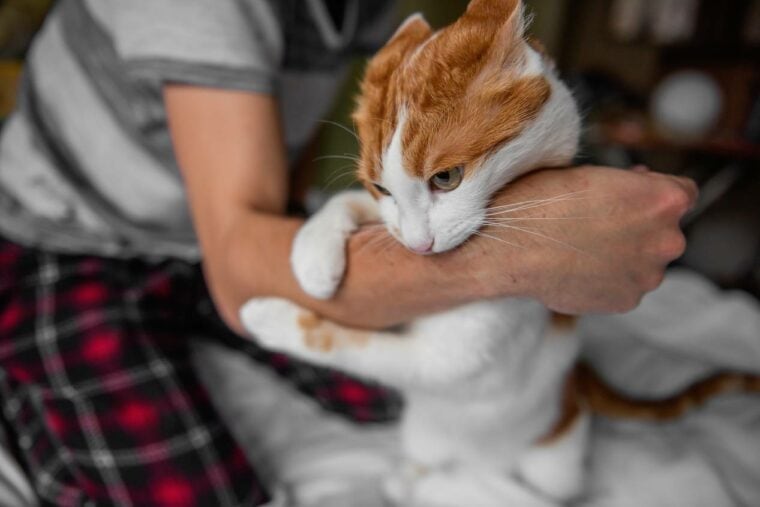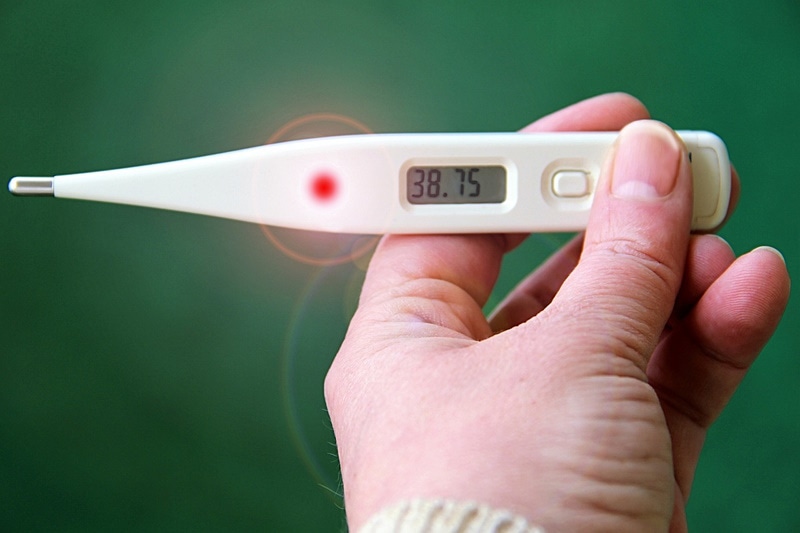
Cats may appear small and cute, but it’s important to handle them respectfully. Cats that feel threatened may end up scratching or biting you as a means of self-defense. While most cat bites can be treated by cleaning the wound and disinfecting it, some cat bite wounds can become infected.
There are several different signs and symptoms associated with the different kinds of infections that you can get after a cat bite. Here are some common signs and types of infections you can be mindful of, should you accidentally get bitten by a cat.
Cat Bite Infection Signs
Note that these are not all the potential signs that a cat bite is infected. However, these are the most common ones that you may experience.
1. Redness
Redness at the site of the cat bite is due to inflammation and is one of the most common signs after getting bitten by a cat, even if the wound doesn’t actually become infected. The shade of redness in an infection can vary from light shades to darker shades, but it’s important to watch the redness to make sure it isn’t spreading.
2. Heat/Fever

Redness at the site of the cat bite may also be accompanied by heat. The bite can feel warm to the touch as your body tries to fight the infection. Sometimes, heat may appear before redness and redness may not accompany heat at all. Heat at the site of the bite is a pretty good indicator that the wound is becoming infected.
Your body may also start to develop fever. This is again due to your body trying to fight off the infection.
3. Pain/Discomfort
Cat bites aren’t comfortable by any means, but usually the pain and discomfort will go away shortly. However, if you have a cat bite that becomes infected, you may start to experience more severe pain and discomfort at the site of the wound. And, as the infection spreads, your pain and discomfort may spread further out around the wound as well.
4. Swelling

Swelling is another common sign of getting bitten by a cat, but it doesn’t necessarily mean that the bite is infected. Mild swelling will usually go away after a couple of days. However, if the swelling continues to get worse and the wound appears bigger, infection is likely, especially if it is accompanied by other symptoms.
5. Pus/Oozing
Infected cat bites may also start to ooze pus and discharge. This is a pretty good indicator of an infection, even if other signs aren’t present. Pus consists of a buildup of dead white blood cells and forms when the body’s immune system responds to an infection. It can develop into a swelling called an abscess.
6. Odor

Sometimes, but not always, infected wounds may develop an odor, especially as the infection progresses. This odor can come from the pus and bacteria accumulating in the wound and can be stronger if the wound isn’t being treated.
Infections from Cat Bites
Here are some of the most common infections that can develop from cat bites and the possible signs and symptoms associated with each. Anyone can develop an infection but children, the elderly, and people who are unwell or immunosuppressed, are at particular risk of developing more severe infections.
Pasteurella Multocida Infection
Cats carry a large number of bacteria in their mouths that are capable of infecting cat bite wounds.One of the more common ones is a bacteria called Pasteurella multocida. The infection can spread through surrounding tissue or even through the blood to other areas of the body , which is a condition called septicaemia.
If infected, you can start to see signs and symptoms develop within 24 hours of a bite.
Capnocytophaga Infection
Both cats and dogs can pass Capnocytophaga bacteria through their saliva but it is rare for it to infect humans. Healthy people can get infected with this bacteria but people who have difficulty fighting off infections are more at risk.The most common first sign of a Capnocytophaga infection is blistering around the bite wound. They’re usually visible within the first few hours of the bite. People who contract this illness can start to show signs within 1-14 days, but it’s more common for them to experience symptoms within 3-5 days.
Capnocytophaga infections can rarely lead to serious complications, like gangrene or sepsis.
Cat Scratch Disease
Bartonella henselae infections, more commonly known as Cat Scratch Disease (CSD), can occur when a cat either bites or scratches a person and breaks the skin. You can experience a mild infection between 3 to 14 days after the bite incident.
In very extremely rare cases, CSD can affect organs, including the brain, eyes, and heart. People who are more at risk of serious complications are children between the ages of 5 to 14 years old and individuals with weaker immune systems.
CSD infections can be fairly common, as about 40% of cats will carry the bacteria at least once in their lifetime. Kittens that are younger than 1 year old are at higher risk of spreading the bacteria to people. Cats become carriers of Bartonella henselae through flea bites and flea droppings getting into their wounds.

Rabies
Rabies is a virus that can be passed on by saliva. It’s extremely dangerous in both animals and humans because there is no current effective treatment. There are extremely rare cases where people survive, but most rabies infections lead to death.
Because of the serious and fatal nature of rabies, it’s important for people who either live or work in areas with higher concentrations of animals with rabies to be vaccinated.
Tetanus
Tetanus is caused by a toxin produced by Clostridium tetani bacteria. When these bacteria enter the body through an open bite wound, they can start to produce a toxin that affects the nervous system. This toxin will affect the muscles and often causes spasms that affect the jaw and neck muscles. This is why tetanus is also known as lockjaw.
People infected by the tetanus bacteria can start to experience signs and symptoms between 3 to 21 days after a wound becomes infected. Because tetanus can be a life-threatening disease, it’s important to make sure that you are up to date with your tetanus booster injections.
Allergic Reaction
Although not an infection, people that have cat allergies can experience allergic reactions from a cat bite. This is because people have allergic reactions to a certain protein called the Fel d 1 protein. Fel d 1 is found in cat hair, saliva, and urine. The severity of symptoms will depend on how severe the person’s cat allergies are.
Since people with cat allergies are sensitive to cat saliva, simply being licked can cause an allergic reaction.
How to Treat Cat Bites Properly

Because cat bites have the potential to become infected and cause serious illness, it is important to see a doctor right away if you have been bitten by a cat and your skin has been broken. When the sharp canine teeth puncture the skin, even though the wounds can look small, they can be deep and penetrate bacteria under the skin.The sooner you receive treatment, the better the chances of your recovery.
Make sure to clean and disinfect the bite wound immediately by using disinfectant soap or salt water and rinsing with warm water. If there is bleeding, apply pressure to the wound with a clean towel until the bleeding stops. Then, apply a clean bandage to the wound to keep it protected.
If you’ve been bitten by a stray or feral cat, it’s especially crucial for you to receive immediate care. You never know what sort of bacteria and diseases they might be carrying. So, it’s better to be safe than sorry and receive care right away rather than waiting to see signs of infection.
Depending on how bad the bite was and the circumstances of the bite your doctor may prescribe antibiotics, a tetanus booster or rabies prophylaxis treatment.
Summary
Due to the risk of infection, cat bites must be taken seriously. So, make sure to treat your bite wound right away and contact your doctor or emergency care to receive treatment as quickly as possible. The sooner cat bites receive appropriate care, the better the chances of a quick, uncomplicated recovery.
Featured Image Credit: Julia Pavaliuk, Shutterstock







